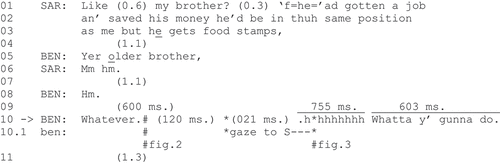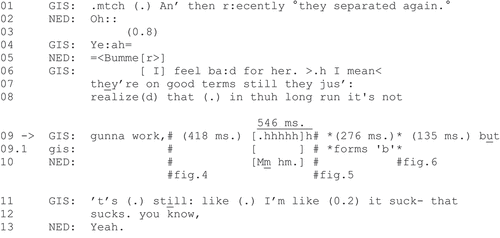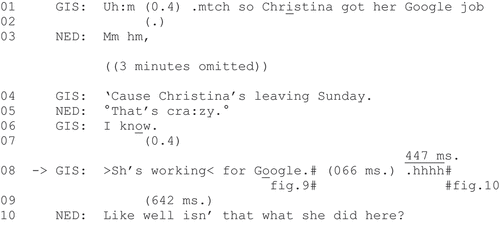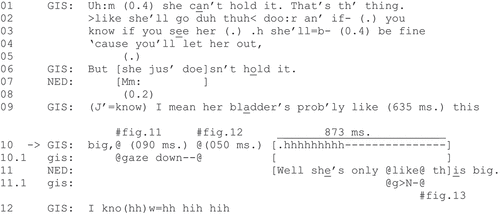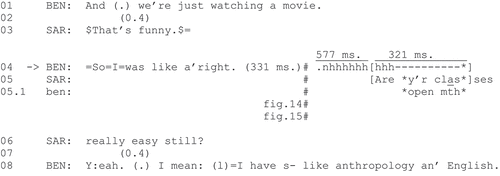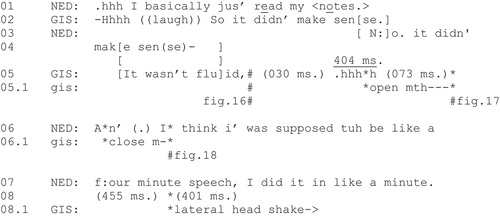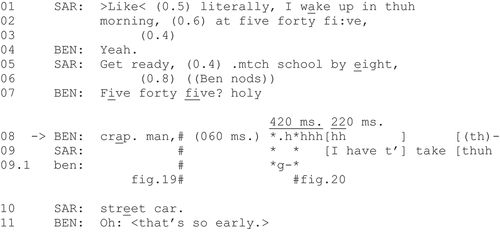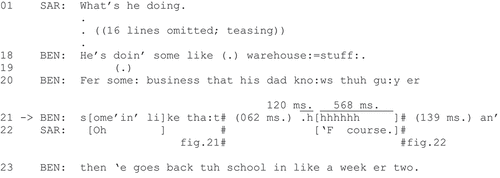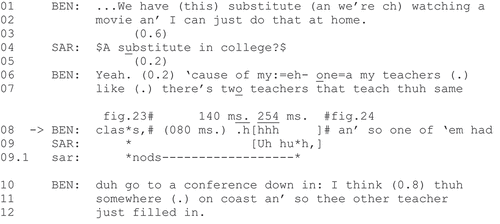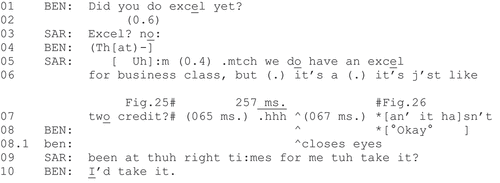ABSTRACT
Extending Jefferson’s analysis of the limited utility of turn-constructional-unit (TCU)-initial particles in managing overlapping talk, this article limits itself to a similar turn-taking context/position in which current speakers bring TCUs to places of possible completion when it is relevant for next speakers to take a turn of talk. This article examines situations in which current speakers continue to audibly inhale in the transition space, arguing that inhalations (a) are pre-beginning actions; (b) bestow a weaker right to speak next than does talk; (c) are not accountable for obscuring next speakers’ talk (if it eventuates); (d) allow for beginning TCUs while monitoring for next speakers’ talk, thereby allowing inhalers to proceed contingently based on next speakers’ unfolding conduct; and (e) are used to mitigate the systemic turn-taking troubles of “no person speaking at a time” and “more than one person speaking at a time.” Data are videotapes of mundane, dyadic, American English conversation.
The system of turn taking for conversation is “susceptible to errors, violations, and troubles” (Sacks et al., Citation1974, p. 723). However, as a locally, interactionally managed system (p. 725), turn taking incorporates “resources and procedures” for dealing with such susceptibilities “into its fundamental organization” (p. 724). This article begins by delimiting and defining the systemic turn-taking troubles to be addressed, and then reviewing a proposed method for mitigating them, which involves audible inhalation.
A “particular” susceptibility identified by Sacks et al. (Citation1974) involves the coordination of turn transfer during the turn-allocational cycling “of options provided by rules 1b and 1c” (p. 724). Jefferson (Citation1983) investigated this susceptibility, and a method for dealing with it, in her examination of beginning turn-constructional units (TCUs) with conjunctionals (e.g., Uh, Well, And, But, Because, So). One of her cases was (which is a slightly retranscribed version of her Extract 5.7, p. 25). Extract 1: It’s cold [Rahman:A:1:(7E):1-2:R]
As Jefferson (Citation1983) did, the present article limits itself to a particular turn-taking context/position in which a current speaker brings a TCU to a place of possible pragmatic and syntactic completion (as Jessie does after “we(h)e(h)ll”; line 7; Ford & Thompson, Citation1996), and thus to a place where it is relevant for a next speaker to take a turn of talk (as Mum does at line 10), be it a “full” turn or some type of continuer (Schegloff, Citation1982).Footnote1 In this context, it is relevant for either a next speaker (e.g., Mum) to select him- or herself to speak next or, if this turn-allocation option (1b) is initially “passed up,” for the current speaker (e.g., Jessie) to continue speaking (turn-allocation option 1c). As evidenced by the long (1.2-second) gap of silence at line 8, there is no guarantee that next speakers (e.g., Mum) will select themselves to speak next, nor that they will do so immediately (i.e., within an average-length transition space; Jefferson, Citation1984).
In these situations, there are two ordered possibilities that would constitute turn-taking troubles—or misfiresFootnote2—in terms of achieving “one speaker at a time” (Sacks et al., Citation1974, p. 726): (a) A next speaker (e.g., Mum) does not immediately speak next (i.e., foregoes turn-allocation option 1b), producing a silence longer than an average-length transition space that constitutes “no speakers at a time,” which happens at line 8Footnote3; and then (b) the current speaker (e.g., Jessie) opts to continue speaking (i.e., turn-allocation option 1c) while the next speaker starts speaking (i.e., turn-allocation option 1b, which is recurrently available to next speakers), producing overlapping talk that constitutes “more than one speaker at a time,” which happens at lines 9–10, where Jessie’s “Su–” (taken by Jefferson to be the beginning of S’) is overlapped by Mum’s “(‘S = ‘e) a’ … ” (i.e., Is he a[lright]). The ordered rules for turn allocation minimize the possibility of these troubles, but do not eliminate them.
If there were to be a method for mitigating these troubles, it makes sense that it would involve how speakers begin their next TCUs (e.g., Jessie in at line 9, or Mum at line 10). VerbalFootnote4 TCU beginnings, however, come with limitations: It is critical that they not be obfuscated by overlapping talk because their recognizability is essential for action ascription (Levinson, Citation2013) and projectability (Sacks et al., Citation1974). With this in mind, Sacks et al. (Citation1974) speculated that one type of beginning might be less “interactionally damaging” if overlapped, that being a conjunctional (e.g., Well, But, And, So): “they do satisfy the constraints of beginning. However, they do that without revealing much about the constructional features of the sentence to follow” (p. 32).
Along these lines, Jefferson (Citation1983) explored the role of conjunctionals in overlap management, referring to them as a practice of “pro-tem speakership”:
[O]ne participant … having just produced a possibly complete utterance [as does Jessie in after “we(h)e(h)ll” at line 7], is now occupying a turn [with a conjunctional] on a ‘pro-tem’ basis [as does Jessie with “Su-” at line 9]; i.e., unless/until another moves to take it [as does Mum at line 10]. Such a participant is ripe for dropping out [as does Jessie at line 9]. (p. 25)
In this turn-taking context, Jefferson (Citation1983) found very limited support for pro-tem conjunctionals as a method for managing overlapping talk: After possibly completing a TCU, if a current speaker continued to speak and began with a conjunctional (as does Jessie at line 9), and if a next speaker began to speak in overlap (as does Mum at line 10), then the current speaker (e.g., Jessie) dropped out only 55% of the time (p. 32).
More recent research refers to conjunctionals as particles (Heritage & Sorjonen, Citation2018). There are at least two reasons why a current speaker continuing with a particle (like Jessie in at line 9) is not an optimal method for addressing the turn-taking susceptibilities described earlier. First, although particles may not reveal much about the action they are beginning to form, the last 50 years of research suggests that TCU-initial particles are nonetheless critical to action formation (Heritage & Sorjonen, Citation2018), and thus their overlap jeopardizes processes of action ascription and projectability (Schegloff, Citation1987b, Citation2004). Second, as a solution to avoid (vs. minimize) overlapping talk, it is not optimal to continue speaking by beginning with something that, if overlapped by talk, constitutes a turn-taking violation, as does overlapping a particle. A more optimal, parsimonious solution, and the focus of this article, is for current speakers to continue by beginning with audible inhalation. Indeed, while not Jefferson’s focus (Jefferson, Citation1983), this may be what happens in , which triggered the observations of this current article: At line 9, Jessie actually begins her next TCU not with a particle but with two bursts of audible inhalation: “.hh .hh.”Footnote5
In the turn-taking context being considered, a current speaker’s post-possible completion, audible inbreath is an elegant method for managing the turn-taking system’s susceptibilities to troubles involving “one speaker at a time.” First, as will be shown, audible inhalation is a practice of action, and thus mitigates the turn-taking misfire of “no speakers at a time” (or at least “no actors at a time”). Second, should an audible inhalation be overlapped, it constitutes the most minimal misfire of “more than one speaker at a time,” and the most minimal obfuscation of the inhalation’s projected, nascent talk/action. This article builds a case defending these claims, providing evidence not only that, but how, audible inhalation is “specifically involved in turn-taking and [can] constitute a coordinative unit for turn-exchange” (Rochet-Capellan & Fuchs, Citation2014, p. 3).
Data and method
Data collection, including the publication of audio and video images, was approved by all relevant institutional review boards. Informed consent was obtained from all participants.
Data were collected in a university room designed to resemble a casual home living room (e.g., carpet, plants, wall pictures, cushion chairs). Data were drawn from face-to-face, dyadic interactions between native-English-speaking good friends engaging in unstructured,Footnote6 mundane conversation. Interactants sat directly across from one another with an intervening coffee table containing a bowl of candy and bottles of water. Data were recorded with four, synchronized, HD cameras, one behind each interactant capturing the other’s torso and face (i.e., representing the participants’ perspectives) and one on each side of the dyad. Researchers were not present during recording.
The microphone (2-channel, 16-bit linear, PCM audio) used to produce transcripts was perpendicular with participants’ sides, positioned level with their heads, and about six feet away from their heads. Participants faced each other and their heads were about five feet apart. The goal was for recorded sound to be equally audible to participants and transcriptionists, so as to ground the relevance of inhalation for participants (Schegloff, Citation1987a). Admittedly, this goal may not have been achieved, given how acoustics are affected by sound-pressure level (SPL; Švec & Granqvist, Citation2018). However, properly measuring SPL would have been intrusive, contradicting conversation analysis’s (CA’s) commitment to naturalistic data collection (Robinson, Citationforthcoming). Transcripts were made by a trained conversation analyst. Research shows that CA transcription of breathing is adequately reliable (Roberts & Robinson, Citation2004). Moving forward, references to “inhalation” are to audible inhalation.
Data were drawn from two complete interactions, totaling 36 and 37 minutes, respectively, and 72 pages of single-spaced transcript. Although this decision was made to get a sense of the phenomenon’s proportionality, data are admittedly limited and thus claims are conjectural (ala. Schegloff, Citation1988a). The entirety of both transcripts were searched for inhalations positioned after TCUs that were brought to places of possible syntactic and pragmatic completion (Ford & Thompson, Citation1996), where the inhalations were (a) produced by the speaker of the prior TCU (i.e., the current speaker) and (b) the first audible conduct produced by the current speaker after his or her prior TCU. Within these parameters, two types of inhalations were excluded so as to not conflate breathing-related actions: (a) inhalations adjacent to laughter or laugh-infused words (see again footnote 4) and (b) sniffs (Hoey, Citation2020).Footnote7 The core collection ultimately consisted of 131 cases.
The method is conversation analysis (Sidnell & Stivers, Citation2013).Footnote8 Data were transcribed according to the standards of CA for both audible (Hepburn & Bolden, Citation2013) and embodied conduct (Mondada; https://www.lorenzamondada.net/multimodal-transcription).Footnote9 Two elements of this article’s measurement and layout of transition-space conduct bear mentioning. Regarding measurement, an average-length transition space (Jefferson, Citation1983, Citation1986; Levinson & Torreira, Citation2015; Schegloff, Citation2000) in English ranges from 157 to 298 milliseconds (Roberts et al., Citation2015). Relatedly, Heldner (Citation2011) demonstrated that gaps of silence <120 ms. are not perceived as such by the human ear. So that analyses can be interpreted relative to these findings, the duration of silence and inhalations surrounding and within focal transition spaces was measured in milliseconds using the software package ELAN, relying on both audio (waveforms) and video of data extracts (Wittenburg et al., Citation2006). While inhalations are standardly symbolized by periods followed by “h”s (e.g., .hhh), their timing is designated above them separated by a solid line (e.g., in , Ben’s inhalation at line 10 lasts for 282 ms.). Regarding layout, it is common practice in CA to transcribe transition-space conduct on separate lines. However, given the focus on the detailed coordination of turn transfer, it is more analytically clear to transcribe this conduct on the same line as current speakers’ talk.
Analysis
This article demonstrates that (and how) audible inhalation—which is a resource and procedure built into the fundamental organization of turn taking—is a practice for managing turn allocation so as to mitigate associated turn-taking misfires. Analysis proceeds with five subsections: (a) Inhalations are pre-beginnings; (b) inhalation is not accountable for obscuring talk; (c) inhalation bestows a weaker right to speak next than does talk; (d) inhalation allows for beginning a TCU while monitoring (for) others’ talk; and (e) additional interactional context regarding sequence organization and gaze orientation.
Audible inhalations are pre-beginnings
TCU-initial, audible inhalations are commonly produced and understood as pre-beginnings (Schegloff, Citation1996). In CA, to say that a stretch-of-conduct “A” is designedly “preliminary” to a stretch-of-conduct “B” is to claim that stretch “A” projects the “contingent possibility” (Schegloff, Citation2007, p. 29, emphasis added) that stretch “B” will be produced, and thus reflexively that stretch “B” may not “subsequently develop” (Schegloff, Citation2007, p. 28, Citation1988b). As pre-beginning actions, the focal inhalations simultaneously project (a) the possibility that the current speaker will continue talking (Schegloff, Citation1996) and (b) that this possibility is contingent on a next speaker beginning to talk, and especially on the nature of that talk, including what it projects (e.g., as an action) and how it intersects with the action just possibly completed by the current speaker. These claims are born out in the data, as seen in and discussed below.
Table 1 Post-Possible-Completion, Audible-Inhalation Events
In the majority of cases (63%; 83 out of 131), current speakers inhale and then continue speaking, with no next-speaker talk interdicting the inhalation (for similar trends, see, Rochet-Capellan & Fuchs, Citation2014; Włodarczak et al., Citation2017). For example, see . At line 1, Ben is referring to waking up for college classes.Extract 2: Alarm [CAS.17_25:04]
Ben’s completion of “ … happening.” (line 10) marks a transition-relevance place, whereupon Ben and Sara share mutual gaze (; because each camera is positioned behind an interactant facing the other’s face and torso, when interactants are gazing toward the camera, they are gazing at the other interactant).
Sara has first turn-taking rights to speak next after “happening.” (line 11). Despite this, after a very brief (040 ms.) silence (which is difficult to hear), Ben begins to inhale for 282 ms. (line 10)—resulting in a longer-than-average transition space (322 ms.)—and then continues speaking to produce another TCU: “An’ lotta times … ” (lines 10–11).
While current speakers’ inhalations can be relatively short (as in ; 282 ms.), it is worth noting that (a) they vary in length and can be relatively long and (b) while there is some evidence that, in spontaneous conversation (vs. reading tasks), inhalation length is associated with ensuing turn length (Rasskazova et al., Citation2019; Rochet-Capellan & Fuchs, Citation20132013; Schegloff, Citation1996), this association is complexly variable (Rochet-Capellan & Fuchs, Citation20132013), with some lengthy inhalations leading to relatively short turns. These observations are reflected in and highlight the fact that inhalers can control the positioning and duration of their inhalations, which is at least partially determined by the needs of interaction, as opposed to being solely determined physiologically (Lerner & Linton, Citationn.d.; Torreira et al., Citation2015). Extract 3: Whatever [CAS:17_21:30]
At line 10, Ben brings his TCU to a transition-relevance place after “Whatever.” (line 10; , where both interactants are gazing away from each other), where Sara has first turn-taking rights to speak next. After a relatively short (but hearable) gap of silence (i.e., 141 ms.; line 10), during which Ben begins to shift his gaze to Sara (line 10.1; Compare , where Ben is gazing at Sara in the latter), Ben inhales for 755 ms. and then continues speaking to produce another TCU: “Whatta y’ gunna do.” (lines 10).
Ben’s “Whatta y’ gunna do.” (lines 10) spans 603 ms., which is shorter than his inhalation of 755 ms.
In 23% of the cases (30 out of 131; ), current speakers’ inhalations span the majority, or all, of a next speaker’s incoming, verbal turn. In these cases, inhalations effectively “absorb” the incoming turn, and inhalers go on to produce a next TCU. For example, see Giselle’s inhalation in at line 9. Extract 4: Not Gunna Work [CAS:34_14:40]
After “ … gunna work,” (line 9), Giselle arrives at a transition-relevance place where Ned has first turn-taking rights to speak next (, where Giselle is not gazing at Ned, but he is gazing at her).
There ensues a 418 ms. gap of silence (line 9), which is longer than an average transition space, where Ned might be characterized as foregoing his initial right to speak next. Giselle begins to inhale (line 9) while Ned simultaneously begins to produce an acknowledgment token: “Mm hm.” (line 10). Giselle’s inhalation, which spans 546 ms., completely overlaps and extends slightly beyond Ned’s talk. As Giselle inhales, she opens her mouth (compare and ). After Giselle completes her inhalation, she immediately closes her mouth (line 9.1) to form the “b” sound of “but” (line 9; ). Soon after, Giselle produces a TCU: “but ’t’s (.) still: like … ” (lines 9–11).
Although perhaps expectable, it is worth noting that, in all of these 30 cases, next speakers’ incoming TCUs are short (e.g., lexical) and implement actions that are relatively nonconstraining in sequence-organizational terms, including continuers (e.g., Mm hm, Uh huh, Yeah), acknowledgment tokens (e.g., Hm, Yeah, Okay, Right, Of course), (dis)agreement tokens (e.g., Yeah, Maybe), assessments (e.g., God), newsmarks (e.g., Really?), open-class repair initiators (e.g., What?), and several beats of laughter (e.g., Huh huh).
The fact that the majority of inhalations (86%; ) lead directly to inhalers continuing to talk—whether or not next speakers take a turn of talk—supports the claim that, as a pre-beginning behavior, inhalation projects talk, even though that eventuality is contingent (see below). Other evidence includes the fact that inhalations are often accompanied by speech-preparatory conformations of the mouth, lips, tongue, eyebrows, and so on (Lerner & Linton, Citationn.d.; Rasskazova et al., Citation2019; Robinson, Citationforthcoming; see especially Extracts 4, 5, 9, 11, and 12), or in tandem with speech projective gestures (data available on request).
The contingent nature of inhalations as preliminary behaviors is most clearly exposed in 12% of the data (16 of 131 cases; ); here, in response to next speakers’ incoming verbal turns, current speakers/inhalers can be characterized as abandoning their projected talk. For example, see . Extract 5: Trucking [CAS:17_14:30]
The possible completion of Sara’s “I think.” (line 5) constitutes a transition-relevance place where Ben has first turn-taking rights to speak next. After a hearable 131-ms. gap of silence (line 5), Sara begins inhaling (line 5) while Ben simultaneously begins speaking: “Does he … ” (line 6). As Sara inhales, she pokes her head forward, raises her chin, furrows her eyebrows, and purses her lips in preparation for speaking (compare , wherein both interactants are gazing at each other).
After inhaling for 308 ms.—which overlaps Ben’s “Does he … ” (line 6), which projects that he is constructing an interrogative clause/action that Sara will be accountable for answering—Sara cuts herself off (symbolized in the transcript by a dash), and allows Ben to complete his question (lines 6–7). In 15 out of 16 (94%) of these cases—and in stark contrast to the 30 cases in which inhalation absorbs incoming talk (see above)—next speakers’ incoming TCUs are (mostly) clausal and implement actions that are relatively constraining in sequence-organizational terms (e.g., questions, Did she give you this advice? and informings, But she’s working for thuh Google).
Relative to these trends, 2 of 131 cases (2%; ) are outliers. In these cases, current speakers inhale, after which there ensues a marked stretch of silence (i.e., inhalers do not go on to produce talk), whereupon next speakers eventually take a turn of talk. For example, see . Three minutes prior to our focus (at line 8), Giselle had announced that “Christina got her Google job” (line 1), and this was acknowledged by Ned: “Mm hm,” (line 3). Extract 6: Working for Google [CAS.34_5:39]
At line 8, Giselle’s “>Sh’s working< for Google.” (line 8) implements a positive assessment (i.e., of Christina’s acquisition of a job with Google’s corporate headquarters). The completion of “… Google,” whereupon Giselle and Ned share mutual gaze (), constitutes a transition-relevance place where Ned has first turn-taking rights to speak next. Despite this, after a brief (066 ms.) silence (which is difficult to hear), Giselle immediately begins to inhale for 447 ms., during which she slightly widens and opens her mouth (compare ).
Giselle then then stops inhaling (at least audibly) and there ensues a 642-ms. silence (line 9), during which Giselle and Ned continue to share mutual gaze (and during which Ned does not embody registration of Giselle’s prior action, for example, by nodding or raising his eyebrows), and after which Ned eventually takes a turn (line 10). The end of section ’Inhalation can be used to absorb incoming talk' includes an analysis of how this outlier case can be explained.
Audible inhalation is not accountable for obscuring talk
Although perhaps obvious, it is worth documenting that inhalers are able to hear and understand talk that overlaps their inhalation (which is not always the case with overlapping talk; Robinson, Citation2006; Schegloff, Citation1987b). For example, see , wherein Giselle is talking about her dog’s inability to hold her urination. Extract 7: Bladder [CAS:34_27:52]
At line 9, Giselle accounts for her dog’s inability to hold her urination by asserting that her bladder is small. Giselle’s completion of “big,” (line 9–10) marks a transition-relevance place, whereupon both interactants share mutual gaze (). In the ensuing 90 ms. of silence (line 10), Giselle shifts/lowers her gaze away from Ned (line 10.1; ).
Simultaneous with Giselle beginning to inhale (line 10), Ned begins to speak (line 11). Through Ned’s “Well she’s only …, ” Giselle inhales while gazing away from Ned. Across Ned’s “like,” Giselle shifts her gaze up to Ned ().
The key observation is that Giselle responds to Ned’s assessment on time (i.e., within an average-length transition space) and with a relevant action, “I kno(hh)w” (Mikesell et al., Citation2017), which is evidence that she heard Ned’s talk and understood its action (line 11) despite the fact that it was almost entirely overlapped (i.e., “Well she’s only like th … ”) by her inhalation (line 10), and despite the fact that she was not gazing at him (line 11.1). Similar observations can be made about .
The fact that inhalers are able to hear and understand talk that overlaps their inhalation contributes to the fact that inhalation is not accountable for obscuring talk (re. accountability, see Robinson, Citation2016). This fact is well documented in other turn-taking contexts. For example, prospective next speakers systematically overlap final components of current speakers’ TCUs with inhalation (Jefferson, Citation1983; Lerner & Linton, Citationn.d.), thereby orienting to inhalation as not obscuring current speakers’ talk. My data additionally support this claim in three ways. First, according to the rules for turn taking, Ned (in ) has first rights to speak next at line 11, yet Giselle does not drop out when she can hear Ned’s talk, which is typical during competing, overlapping streams of talk (Schegloff, Citation2000); stated positively, Giselle continues to inhale for 873 ms. even though she can hear that Ned is talking. Second, throughout his turn (line 11), Ned does not produce any of the typical hitches or perturbations commonly found during extended stretches of two streams of overlapping talk (e.g., cutoffs, pauses, sound stretches; Schegloff, Citation2000). Third, Ned does not exhibit typical signs of turn-space competition, such as increasing volume (Schegloff, Citation2000). Thus, there is no indication that either Ned or Giselle orient to her inhalation as obscuring or competing with Ned’s talk, at least in the same way as does talk.Footnote10 Similar observations can be made about and Extracts 8, 11, and 12. Although the next subsection makes a distinct point, it too contains evidence for the claim that inhalation is not accountable for obscuring talk.
Audible inhalation bestows a weaker right to speak next than does talk
Although the focal inhalations are pre-beginning actions, they “are not yet proper recognizable beginnings” (Schegloff, Citation1996, p. 92, emphasis added). These inhalations bestow a weaker right to speak next than does talk. According to Sacks et al. (Citation1974), “The basic technique for self-selection is ‘starting first.’ Rule 1b explicitly incorporates this in its provision that ‘first starter gets the turn’” (p. 718). Sacks et al. additionally argued that “the first-starter provision … operates without respect to type of utterance” (p. 720, emphasis added). I argue that the first-starter provision applies to “utterances,” and that the inhalations examined herein are not treated as utterances (see also, Jefferson, Citation1984, p. 19). Evidence for this claim is found in cases in which (a) enough time elapses after a current speaker brings his or her TCU to a place of possible completion where next speakers can be characterized as foregoing their initial right to speak next; (b) next speakers have ample access to current speakers’ audible (and sometimes visible) inhalations; and (c) next speakers nonetheless come in to speak in overlap with the inhalation. For example, see . Extract 8: Really easy [CAS:17_05:08]
Ben’s completion of “ … like a’right.” (line 4) constitutes a transition-relevance place where Sara has first turn-taking rights to speak next. After a 331-ms. gap of silence, which is longer than an average transition space, and thus after Sara can be characterized as foregoing her initial right to speak, Ben begins to inhale nasally (line 4). When Ben begins to inhale, he and Sara share mutual gaze (). As Ben completes his inhalation, he opens his mouth (line 5.1; ).
Sara begins to speak as Ben is audibly and visibly inhaling, and after he has been doing so for 577 ms. Thus, it is likely that Sara “knowingly” or “motivatedly” starts talking during (i.e., in overlap with) Ben’s inhalation; Sara treats Ben’s inhalation as only projecting talk provisionally, that is, unless she begins speaking. Similar points can be made about Extracts 9, 10, and 12. These cases are additional evidence for the claim that current speakers’ post-possible-completion inhalations are not accountable for obscuring talk (see previous subsection), insofar as next speakers treat the midst of current speakers’ inhalations as appropriate places to initiate talk (see also Jefferson, Citation1984). As noted about Ned in , Sara’s turn (in , lines 6–7) does not exhibit any of the signs of turn-space competition typical of overlapping streams of talk (e.g., hitches, perturbations, increased volume, recycled beginnings; Schegloff, Citation1987b, Citation2000).
Audible inhalation allows for beginning a TCU while monitoring (for) talk and its action
We have seen that current speakers’ inhalations project talk, but only provisionally, contingent on next speakers’ talk. Furthermore, such inhalations are not accountable for obscuring overlapping talk and do not stake an official claim to the turn space (as does talk). These features provide for inhalation being a practice for effectively beginning a TCU while monitoring for the occurrence of incoming talk and, if it overlaps the inhalation, concurrently monitoring the content of that talk and its associated projectable action. When next speakers produce talk sometime during current speakers’ inhalations (which happens 35% of the time; 46 of 131 cases; ), current speakers sometimes (in 16 cases) abandon their inhalation and its projected talk, but other times (in 30 cases) they inhale through (the majority of) next speakers’ talk, effectively absorbing it. This suggests that inhalers react contingently to the advent and/or nature of next speakers’ talk that interdict inhalations.
Inhalers sometimes abandon their projected talk
As reported earlier, in 12% of the data (16 of 131 cases; ), current speakers abandon their inhalation and its projected talk. We have already seen two examples of this. First, in Sara cuts off her inhalation and ultimately answers Ben’s interdicting question. Second, in Giselle abandons her inhalation after 873 ms. (line 10) and ultimately responds to Ned’s interdicting turn. For the first of two more examples, see . As context, Ned is describing his poor technical performance when giving a public speech in college ten years ago. Extract 9: Fluid [CAS:34_32:56]
Giselle’s completion of “ … fluid,” (line 5) constitutes a transition-relevance place where Ned and Giselle share mutual gaze (). While Ned has first turn-taking rights to speak next, after a very brief (030 ms.) gap of silence (which is difficult to hear), Giselle begins to inhale for 404 ms. As she inhales, she closes her eyes and opens her mouth in preparation for speaking (). Before she begins speaking, Ned continues to describe his poor performance (i.e., he spoke too fast; lines 6–7). As Ned begins to speak—that is, across “An’ I … ” (line 6)—Giselle abandons her projected talk by closing her mouth (line 6.1) and returns her gaze to Ned ().
Ned interdicts Giselle’s inhalation to relate another element of his poor public-speaking performance (lines 6–7), to which Giselle responds with an assessment in the form of a lateral head shake (line 8.1; Goodwin & Goodwin, Citation1992).
For the second example, see . Extract 10: Holy crap [CAS.17_24:51]
Ben’s repeat, “Five forty five?” (cf. line 2, “ … five forty fi:ve,”) characterizes Sara’s wake-up time as being problematically early (Bolden, Citation2009; Robinson, Citation2013). This claim is supported by Ben’s subsequent expletive, “holy crap.” (lines 7–8; Hoey et al., Citation2021) and address term, “man,” (line 8; Clayman, Citation2010). At this point, Ben is gazing down and away from Sara, who is gazing at Ben (). Ben’s completion of “ … man,” constitutes a transition-relevance place where Sara has first turn-taking rights to speak next. However, after a short (60 ms.) silence (which is difficult to hear), Ben begins to inhale (line 8). Across the first 125 ms. of his inhalation, Ben shifts his gaze up to Sara (line 9.1; ).
After Sara begins to speak—that is, begins to produce an account for her early wake-up time (i.e., she has to take public transportation, the “street car,” to get to school)—Ben continues to inhale for an additional 220 ms. before producing a cutoff, non-phonated sound approximating a dental fricative: “(th)–” (line 8). Ben’s dropping out displays his orientation to Sara as having rights to the turn space (Sacks et al., Citation1974; Schegloff, Citation2000). Ben’s cutoff “(th)–” is evidence that his inhalation was initially preliminary to his continuing speaking. It is possible that Ben’s cutoff “(th)–” was the beginning of his subsequent assessment: “<th[at’s so early]>” (line 11). If so, Ben can be characterized as initially responding to Sara’s account, “Oh:” (line 11), before recycling (Schegloff, Citation1987b) his cutoff assessment. In sum, in these 16 cases, current speakers appear to use their inhalation as a space to monitor (for) next speakers’ incoming talk and its action; in most cases, current speakers assess this action as making overt responses accountable by halting their inhalation, allowing next speakers to complete their TCUs, and then overtly responding to these actions.
Inhalation can be used to ‘absorb’ incoming talk
The fact that inhalation is not accountable for obscuring talk provides for inhalation being used to absorb possibly incoming verbal action by other interactants. I use the term “absorb” in two of its definitional senses, including “to take in … in a natural or gradual way,” but also “to receive without recoil or echo” (https://www.merriam-webster.com/dictionary/absorb). We saw one example of this in . For a second example, see . Extract 11: Warehouse stuff [CAS:17_28:05]
Ben’s completion of “ … tha:t” (line 21) marks a transition-relevance place where Sara has first turn-taking rights to speak next (). Despite this, after a short (062-ms.) pause (which is difficult to hear), Ben begins to inhale while shifting his gaze away from Sara and slightly opening his mouth in preparation for continuing speaking (, where Sara continues to gaze at Ben).
After an average-length (182-ms.) transition space—including a small (062-ms.) gap of silence and 120 ms. of Ben’s inhalation (line 21)—and in complete overlap with Ben’s inhalation, Sara produces “‘F course.” (line 22). The offset of Ben’s inhalation is precisely timed with that of Sara’s “‘F course.,” whereupon Ben produces a next TCU: “an’ then ‘e goes back … ” (lines 21–23).
In Extracts 4 and 11, current speakers begin inhaling after their talk arrives at a possible-completion place that is also a transition-relevance place. As seen in , situations in which inhalation effectively absorbs next speakers’ talk can also occur when current speakers’ talk arrives at a possible-completion place that is not a transition-relevance place, such as after TCUs that are projectably non-final parts of larger courses of action. Here, Ben informs Sara that he did not attend a college course because it was taught by a “substitute” (lines 1–2). Sara’s repair initiation, which is formatted as a partial-questioning repeat, “$A substitute in college?$” (line 4), makes relevant an explanation or justification (Robinson, Citation2013). Ben begins to provide an explanation, “‘cause of my: = eh- one = a my teachers … ” (line 6), but abandons doing so in lieu of providing a piece of background information: “like (.) there’s two teachers that teach thuh same class,” (lines 7–8). Thus, although the end of “ … class,” (line 8) marks a possible-completion place, Ben’s turn is not yet transition relevant because he has not yet completed his projected explanation. Extract 12: Same class [CAS:17_4:52]
Across the final sound of “ … class,” (line 8), Sara begins to nod (line 9.1; , where Ben is gazing at Sara, but she is not gazing at him). After a short (080-ms.) silence (which is difficult to hear), Ben begins to inhale (line 8). As he inhales, Ben opens his mouth in preparation for speaking (compare ).
Shortly after Ben begins to inhale—and within an average-length transition space after Ben’s “ … class,” (i.e., the pause and first .h of Ben’s inhalation lasts 224 ms.)—Sara produces a continuer (Schegloff, Citation1982), “Uh huh,” which is ultimately absorbed by Ben’s inhalation. Precisely timed with the completion of Sara’s “Uh huh,” Ben produces a next TCU: “an’ so one of ‘em … ” (Line 8).
The contrast between these 30 cases and the 16 discussed in the previous section suggests that current speakers, while inhaling, monitor next speakers’ overlapping talk for its accountable sequential implications and contingently adjust their subsequent behavior accordingly. In virtually every case, this involves either dropping out in the face of interdicting talk section or absorbing incoming talk and then continuing to talk section. But there are other possibilities, suggested by the previously described “outlier,” . Although Giselle produces an assessment at line 8, and although most assessments are responded to (Stivers & Rossano, Citation2010), and although Giselle ends her assessment gazing at Ned (which is a feature that mobilizes response; and ), her assessment is produced with declarative (vs. interrogative) syntax, with final-falling (vs. rising) intonation, and in a context of epistemic symmetry (vs. asymmetry), and these latter three features render the action, and its response relevance, more ambiguous (Stivers & Rossano, Citation2010). We can speculate that, after Giselle’s inhalation—during which she perhaps expects a response—she contingently halts her inhalation and pursues a response, as detailed by Stivers and Rossano—that is, by continuing to gaze at Ned for 642 ms. (line 9), which succeeds.
Practice does not make perfect
Although the inhalation practice being proposed mitigates turn-taking misfires, it does not completely prevent them. For one example, see . At line 1, Ben asks Sara if she has taken a college-level course on the software program Excel. Sara accounts for answering “no” (line 3) by explaining that the available course is only a half-credit course (i.e., two vs. four credits; lines 5–7). Extract 13: Excel [CAS.17_10.30]
Sara brings her TCU to possible completion after “ … two credit?” (line 7). At this point, Sara and Ben share mutual gaze () and Ben has first turn-taking rights to speak next.
After a brief (065 ms.) silence (which is difficult to hear), Sara inhales for 275 ms., creating a longer-than-average transition space (of 340 ms. so far). Throughout her inhalation, Sara and Ben maintain mutual gaze (similar to ). Immediately after Sara’s inhalation, Ben closes his eyes (line 8.1) and they begin speaking simultaneously (): Sara continues to account for not taking the class, and Ben produces the acknowledgment token, “°Okay°” (line 8).
If Sara’s inhalation projects the possibility of her continuing speaking contingent on Ben’s next turn, and if Ben has (so far) opted not to speak in the longer-than-normal transition space (at line 7), it may not be coincidental that when he takes his turn, “°Okay°” (line 8), he produces it quietly (symbolized in the transcript by the degree signs) so as to mitigate its disruption of Sara’s next TCU.
Additional interactional context
A turn-taking context/position has already been specified: Inhalations are produced by speakers of immediately prior TCUs (i.e., current speakers), when those TCUs have been brought to places of possible syntactic and pragmatic completion, and when the inhalations are the first audible conduct after those TCUs. Although space limitations prevent the detailed exploration of other interactional contexts that likely factor into the operation of inhalation, two are characterized grossly below: Sequence organization and interactants’ gaze orientation.
Sequence-organizational context
As seen in , 32 of 131 inhalations (25%) are positioned immediately after “backward-looking,” responsive TCUs (e.g., conditionally relevant answers to questions, acknowledgment and reactive tokens) that arguably do not normatively mandate responses (e.g., Sara’s “I think.” in ). The remaining 99 inhalations (75%) are positioned after “forward-looking” actions. Only three of 99 (03%) of these forward-looking actions are canonical first parts of adjacency-pair sequences, including a request for a first name, a request for confirmation, and a pre-telling. Notably, these three actions mandate relatively short answers (e.g., a first name, (dis)confirmation, and a go-ahead, respectively) that can be absorbed by relatively short inhalations (compared to actions that mandate clausal-length answers, or ones potentially composed of multiple TCUs). In 15 cases, the forward-looking actions are implemented through possibly complete TCUs that are not transition relevant (e.g., non-final story components, prospective indexicals, first answers to questions that mandate more than one answer; see Ben’s inserted piece of background information in ). The remaining 81 forward-looking actions can be variously characterized as informings, assertions, assessments, formulations, and so on (e.g., Ben’s assertion in , line 11: “An that- that’s not happening.”); these actions vary in terms of how they mobilize responses (or not; Stivers & Rossano, Citation2010).
Table 2 Sequence-Organizational Position of Audible Inhalations
Gaze-orientation context
Although the function of gaze orientation is complexly affected by action type and its sequence-organizational position (Rossano, Citation2012), a general finding is that completing an action gazing at (vs. away from) an interactant increases that action’s response relevance for that person (for review, see Rossano, Citation2012). Understanding the focal practice of inhalation may be increased by knowing interactants’ gaze orientations after the possible completion of current speakers’ pre-inhalation TCUs (e.g., ), and how such orientations may have affected next speakers’ verbal entry. reports gaze configurations for the majority (62%) of the data, that is, the 81 cases () in which pre-inhalation TCUs implemented forward-looking, transition-relevant actions; excludes the noncomparable cases of canonical first-parts of adjacency pair sequences (which clearly select next speakers) and nontransition-relevant actions (which hold the turn for current speakers).
Table 3 Interactants’ Gaze Orientation at the Possible Completion of a Subset of TCUsa
Although certainly not definitive, a cross-tabulation () of interactants’ mutual gaze orientation during these 81 cases (vs. nonmutual gaze) with cases in which next speakers spoke during (or immediately adjacent to) inhalations (vs. not) suggests that gaze orientation (at least at TCU completion) was not strongly associated with next speaker talk. In fact, in 66% of the cases in which interactants shared mutual gaze, next speakers did not come in to talk. That next speakers do not come in to talk at these turn-taking junctures is not uncommon (Robinson, Citation2014), at least because interactants do not rely exclusively on next-turn talk to manage intersubjectivity (e.g., interactants also rely on the tacit organization of repair; Robinson, Citation2014).
Table 4 Association Between Interactants’ Mutual Gaze Orientation and Next Speakers’ Production of Talk for a Subset of TCUsab
Discussion
This article argues that audible inhalation, as “a coordinative unit for turn-exchange” (Rochet-Capellan & Fuchs, Citation2014, p. 3), is a practice for mitigating systemic turn-taking troubles. This article limits itself to a particular turn-taking context/position in which current speakers bring TCUs to places of possible syntactic and pragmatic completion (Ford & Thompson, Citation1996), and thus to places where it is relevant for next speakers to take a turn of talk, be it a “full” turn or some type of continuer (Schegloff, Citation1982). This article examines situations in which current speakers’ next conduct is audible inhalation. These inhalations are shown to be pre-beginning behaviors (Schegloff, Citation1996), projecting the contingent possibility of talk. Evidence is provided that audible inhalation is not accountable for obscuring talk and bestows a weaker right to speak next than does talk. These observations are collectively used to conjecture that inhalation allows current speakers to begin TCUs while monitoring (for) others’ talk, that inhalers proceed contingently based on whether or not (and how) next speakers come in to talk, and that inhalation is a practice for mitigating the systemic turn-taking troubles of “less than one speaker at a time” and “more than one speaker at a time.”
If we consider audible inhalation to be a type of “talking”—that is, a type of pre-talking, which is a type of (projective) action—then it mitigates one type of turn-taking trouble by reducing the amount of time in which “no interactant is talking” (or at least acting) between the possible-completion point of a current TCU and the verbal beginning of a next TCU (by either current or next speaker). displays these differentials for this article’s extracts.
Table 5 Differential Transition-Space Lengths With and Without Audible Inhalation
As a type of behavior that is not accountable for obscuring talk, audible inhalation is a talk-relevant action that is protected against being implicated in a second type of systemic turn-taking trouble: Inhalation being overlapped by next speakers’ talk does not appear to constitute “more than one interactant talking at a time.” This feature provides at least two affordances. First, as a type of TCU beginning, inhalation is a practice of pro-tem-speakership (Jefferson, Citation1983) that manages the potential overlap of (near) simultaneous verbal starts by other speakers. For example, in Extracts 4, 5, 7, 11, and 12, next speakers begin to talk (virtually) simultaneously with the onset of current speakers’ inhalations.
Second, current speakers are able to continue to inhale in tandem with next speakers’ verbalizations without either party having to engage in overlap-resolution strategies described by Schegloff (Citation2000). This was particularly evident in , in which the inhalation overlaps talk for 873 ms., but also in Extracts 4, 8, 11, and 12. This feature affords current speakers the possibility of continuing to inhale as next speakers talk while monitoring its progressively unfolding action. If inhalers deem it necessary to overtly respond to next speakers’ unfolding actions, inhalers can abandon their inhalation and respond (i.e., after next speakers’ TCUs are possibly complete). Alternatively, inhalers can continue to inhale through the entirety of next speakers’ turns, and thus continue to project whatever action the inhalation initially projected, and then continue to produce that action after next speakers’ turns are (projectably) complete.
Given that a majority of next speakers do not come in to talk during, or adjacent to, current speakers’ inhalations (see, ), data do not support the claim that inhalation is a practice for soliciting next speaker talk. That said, inhalations are positioned at points where, according to the rules for turn taking (Sacks et al., Citation1974), next speaker entry is relevant. If inhalation is a practice for provisionally beginning a TCU while monitoring for the occurrence of incoming talk in order to contingently act on it, then inhalation may reiterate/reinforce the relevance of next speaker talk while not making it conditionally relevant (Schegloff, Citation1968). In other words, inhalation—perhaps especially when it is positioned after, or when its duration surpasses the length of, an average-length transition space (e.g., 157–298 ms. in English; Roberts et al., Citation2015)—might be characterized as a designed entry-opportunity space for next speakers, or a space in which next-speaker talk is accountable above and beyond that afforded by the rules for turn taking.
At least two paths for future research are as follows: First, in this article’s focal turn-taking context/position, what is the role of next speakers’ embodied conduct in managing turn allocation, such as their head nodding/shaking (which, being solely embodied, has special affordances in terms of beginning prior to possible-completion places; see , line 9.1)? Second, what is the range of transition-space practices, and (how) are they consequential for ensuing action? A common assumption is that a transition space is composed of silence, but clearly it can be “built” with other materials, such as audible inhalation, and can be differentially composed of different amounts of multiple materials (e.g., [silence + inhalation] versus [inhalation + silence]).
Acknowledgments
The author thanks Galina Bolden for comments on a previous draft.
Disclosure statement
No potential conflict of interest was reported by the authors.
Notes
1 Here and throughout, a distinction is made between “relevant” and “conditionally relevant”: (Schegloff, Citation1968), the use of the former term not implicating the latter.
2 “Misfire” in the sense of “to miss an intended effect or objective” (https://www.merriam-webster.com/dictionary/misfire)]]
3 This is excepting circumstances in which interactants negotiate a lapse (Hoey, Citation2015).
4 By “verbal,” I do not mean to exclude behaviors like Uh(m), Mm, and so on.
5 Admittedly, the function of these inhalations may be conflated by Jessie’s laughter at line 7 (see Data/Methods).
6 Interactants were instructed to “just talk like normal.”
7 For example, in Extract A, Giselle has had trouble formulating a position, and ultimately abandons it with, “You know what I’m tryin’ duh s(h)a(y)” (line 1), infusing the last word with laughter (symbolized in the transcript by ‘h’s in parentheses). Giselle immediately inhales (line 3) and produces a next TCU, “You get me”. In total, 13 post-laughter inhalation cases were omitted due to analytic caution (e.g., perhaps Giselle’s inhalation is a post-completion stance marker; see Schegloff, Citation1996), but it is unclear if they operate differently than those in the core collection.
Extract A: You get me [CAS.34_7.50]
Sniffing is wholly different from the focal phenomenon, and three cases were omitted, including Extract B (line 5).Extract B: What I don’t get [CAS.34_12.59]
8 For a different method of studying inhalation (audible and inaudible) in conversation, see Włodarczak and Heldner (Citation2020) for review and analysis.
9 One slight departure is that embodied conduct is assigned a line number with a decimal point. For example, in , Ben’s embodied conduct that co-occurs with his talk at line 10 is designated as line 10.1.
10 Although readers might object that these are “negative” observations (Schegloff, Citation2007), they are grounded in normative practices of overlap management and resolution (Schegloff, Citation2000).
References
- Bolden, G. B. (2009). Beyond answering: Repeat-prefaced responses in conversation. Communication monographs, 76(2), 121–143.
- Clayman, S. E. (2010). Address terms in the service of other actions: The case of news interview talk. Discourse & Communication, 4(2), 161–183. https://doi.org/10.1177/1750481310364330
- Ford, C., & Thompson, S. A. (1996). Interactional units in conversation: Syntactic, intonational, and pragmatic resources for the management of turns. In E. Ochs, E. A. Schegloff, & S. A. Thompson (Eds.), Interaction and grammar (pp. 134–184). Cambridge University Press.
- Goodwin, C., & Goodwin, M. H. (1992). Assessments and the construction of context. In A. Duranti & C. Goodwin (Eds.), Rethinking context (pp. 147–190). Cambridge.
- Heldner, M. (2011). Detection thresholds for gaps, overlaps, and no-gap-no-overlaps. The Journal of the Acoustical Society of America, 130(1), 508–513. https://doi.org/10.1121/1.3598457
- Hepburn, A., & Bolden, G. B. (2013). The conversation analytic approach to transcription. In J. Sidnell & T. Stivers (Eds.), Handbook of conversation analysis (pp. 57–76). Wiley-Blackwell.
- Heritage, J., & Sorjonen, M. L. (Eds.). (2018). Between turn and sequence: Turn-initial particles across languages (Vol. 31). John Benjamins.
- Hoey, E. M. (2015). Lapses: How people arrive at, and deal with, discontinuities in talk. Research on Language and Social Interaction, 48(4), 430–453. https://doi.org/10.1080/08351813.2015.1090116
- Hoey, E. M. (2020). Waiting to inhale: On sniffing in conversation. Research on Language and Social Interaction, 53(1), 118–139. https://doi.org/10.1080/08351813.2020.1712962
- Hoey, E. M., Hömke, P., Löfgren, E., Neumann, T., Schuerman, W. L., & Kendrick, K. H. (2021). Using expletive insertion to pursue and sanction in interaction. Journal of Sociolinguistics, 25(1), 3–25. https://doi.org/10.1111/josl.12439
- Jefferson, G. (1983). On a failed hypothesis: ‘Conjunctionals’ as overlap-vulnerable. Tilburg Papers in Language and Literature, No. 28, 1–33. Tilburg University.
- Jefferson, G. (1986). Notes on ‘latency’ in overlap onset. Human Studies, 9(2/3), 153–183. https://doi.org/10.1007/BF00148125
- Jefferson, G. (1984). Notes on some orderlinesses of overlap onset. In V. D’Urso & P. Leonardi (Eds.), Discoure analysis and natural rhetoric (pp. 11–38). Cleup Editore.
- Lerner, G., & Linton, L. D. (n.d.). Before the beginning: Breath taking in conversation.
- Levinson, S. C. (2013). Action formation and ascription. In J. Sidnell & T. Stivers (Eds.), The Handbook of Conversation Analysis (pp. 101–130). Blackwell.
- Levinson, S. C., & Torreira, F. (2015). Timing in turn-taking and its implications for processing models of language. Frontiers in Psychology, 6, 731. https://doi.org/10.3389/fpsyg.2015.00731
- Mikesell, L., Bolden, G. B., Mandelbaum, J., Robinson, J. D., Romaniuk, T., Bolaños-Carpio, A., Searles, D., Wei, W., DiDomenico, S. M., & Angell, B. (2017). At the intersection of epistemics and action: Responding with I know. Research on Language and Social Interaction, 50(3), 268–285. https://doi.org/10.1080/08351813.2017.1340711
- Rasskazova, O., Mooshammer, C., & Fuchs, S. (2019). Temporal coordination of articulatory and respiratory events prior to speech initiation. In Proceedings of Interspeech (pp. 884–888). https://www.isca-speech.org/archive_v0/Interspeech_2019/pdfs/2876.pdf
- Roberts, F., & Robinson, J. D. (2004). Inter-observer agreement regarding ‘first-stage’ conversation-analytic transcripts. Human Communication Research, 30, 376–410.
- Roberts, S. G., Torreira, F., & Levinson, S. C. (2015). The effects of processing and sequence organization on the timing of turn taking: A corpus study. Frontiers in Psychology, 6, 119–134. https://doi.org/10.3389/fpsyg.2015.00509
- Robinson, J. D. (2006). Managing trouble responsibility and relationships during conversational repair. Communication Monographs, 73(2), 137–161. https://doi.org/10.1080/03637750600581206
- Robinson, J. D. (2014). What “What?” tells us about how conversationalists manage intersubjectivity. Research on Language and Social Interaction, 47(2), 109–129. https://doi.org/10.1080/08351813.2014.900214
- Robinson, J. D. (Ed.). (2016). Accountability in social interaction. Oxford University Press.
- Robinson, J. D. (forthcoming). Collecting interaction data in the ‘lab’ versus the ‘field’: Rationale, ramifications, and recommendations. In J. D. Robinson, R. Clift, K. Kendrick, & C. Raymond (Eds.), Handbook of research methods in conversation analysis. Cambridge.
- Robinson, J. D. (2013). Epistemics, action formation, and other-initiation of repair: The case of partial questioning repeats. In J. Sidnell, M. Hayashi, & G. Raymond (Eds.), Conversational repair and human understanding (pp. 261–292). Cambridge University Press.
- Rochet-Capellan, A., & Fuchs, S. (2013, August). The interplay of linguistic structure and breathing in German spontaneous speech. In Interspeech 2013-14th Annual Conference of the International Speech Communication Association (p. 1228). Lyon, France. https://doi.org/10.1098/rstb.2013.0399
- Rochet-Capellan, A., & Fuchs, S. (2014). Take a breath and take the turn: How breathing meets turns in spontaneous dialogue. Philosophical Transactions of the Royal Society B: Biological Sciences, 369(1658), 20130399. https://doi.org/10.1098/rstb.2013.0399
- Rossano, F. (2012). Gaze behavior in face-to-face interaction [Unpublished dissertation]. Radboud University Nijmegen.
- Sacks, H., Schegloff, E. A., & Jefferson, G. (1974). A simplest systematics for the organization of turn-taking for conversation. Language, 50(4), 696–735. https://doi.org/10.1353/lan.1974.0010
- Schegloff, E. A. (1968). Sequencing in conversational openings. American Anthropologist, 70(6), 1075–1095. https://doi.org/10.1525/aa.1968.70.6.02a00030
- Schegloff, E. A. (1982). Discourse as an interactional achievement: Some uses of ‘uh huh’and other things that come between sentences. Analyzing Discourse: Text and Talk, 71, 71–93. https://repository.library.georgetown.edu/bitstream/handle/10822/555474/GURT_1981.pdf
- Schegloff, E. A. (1988a). On an actual virtual servo-mechanism for guessing bad news: A single case conjecture. Social Problems, 35(4), 442–457. https://doi.org/10.2307/800596
- Schegloff, E. A. (1988b). Presequences and indirection: Applying speech act theory to ordinary conversation. Journal of Pragmatics, 12(1), 55–62. https://doi.org/10.1016/0378-2166(88)90019-7
- Schegloff, E. A. (2000). Overlapping talk and the organization of turn-taking for conversation. Language in Society, 29(1), 1–63. https://doi.org/10.1017/S0047404500001019
- Schegloff, E. A. (2004). On dispensability. Research on Language and Social Interaction, 37(2), 95–149. https://doi.org/10.1207/s15327973rlsi3702_2
- Schegloff, E. A. (2007). Sequence organization in interaction: A primer in conversation analysis (Vol. 1). Cambridge University Press.
- Schegloff, E. A. (1987a). Between macro and micro: Contexts and other connections. In J. C. Alexander, B. Giesen, R. Münch, & N. J. Smelser (Eds.), The micro-macro link (pp. 207–234). University of California Press.
- Schegloff, E. A. (1987b). Recycled turn beginnings: A precise repair mechanism in conversation’s turn-taking organization. In G. Button & J. R. Lee (Eds.), Talk and social organisation (pp. 70–85). Multilingual Matters LTD.
- Schegloff, E. A. (1996). Turn organization: One intersection of grammar and interaction. In E. Ochs, E. A. Schegloff, & S. A. Thompson (Eds.), Interaction and grammar (Vol. 13, pp. 52–133). Cambridge University Press.
- Sidnell, J., & Stivers, T. (Eds.). (2013). The handbook of conversation analysis. Blackwell-Wiley.
- Stivers, T., & Rossano, F. (2010). Mobilizing response. Research on Language and Social Interaction, 43(1), 3–31. https://doi.org/10.1080/08351810903471258
- Švec, J. G., & Granqvist, S. (2018). Tutorial and guidelines on measurement of sound pressure level in voice and speech. Journal of Speech, Language, and Hearing Research, 61(3), 441–461. https://doi.org/10.1044/2017_JSLHR-S-17-0095
- Torreira, F., Bögels, S., & Levinson, S. C. (2015). Breathing for answering: The time course of response planning in conversation. Frontiers in Psychology, 6, 284. https://doi.org/10.3389/fpsyg.2015.00284
- Wittenburg, P., Brugman, H., Russel, A., Klassmann, A., & Sloetjes, H. (2006). ELAN: A professional framework for multimodality research. In 5th International Conference on Language Resources and Evaluation (pp. 1556–1559).
- Włodarczak, M., & Heldner, M. (2020). Breathing in conversation. Frontiers in Psychology, 11(575566), 1–17. https://doi.org/10.3389/fpsyg.2020.575566
- Włodarczak, M., Laskowski, K., Heldner, M., & Aare, K. (2017). Improving prediction of speech activity using multi-participant respiratory state. In Interspeech 2017, Stockholm, Sweden, 20-24 August, 2017 (pp. 1666–1670). The International Speech Communication Association (ISCA).





